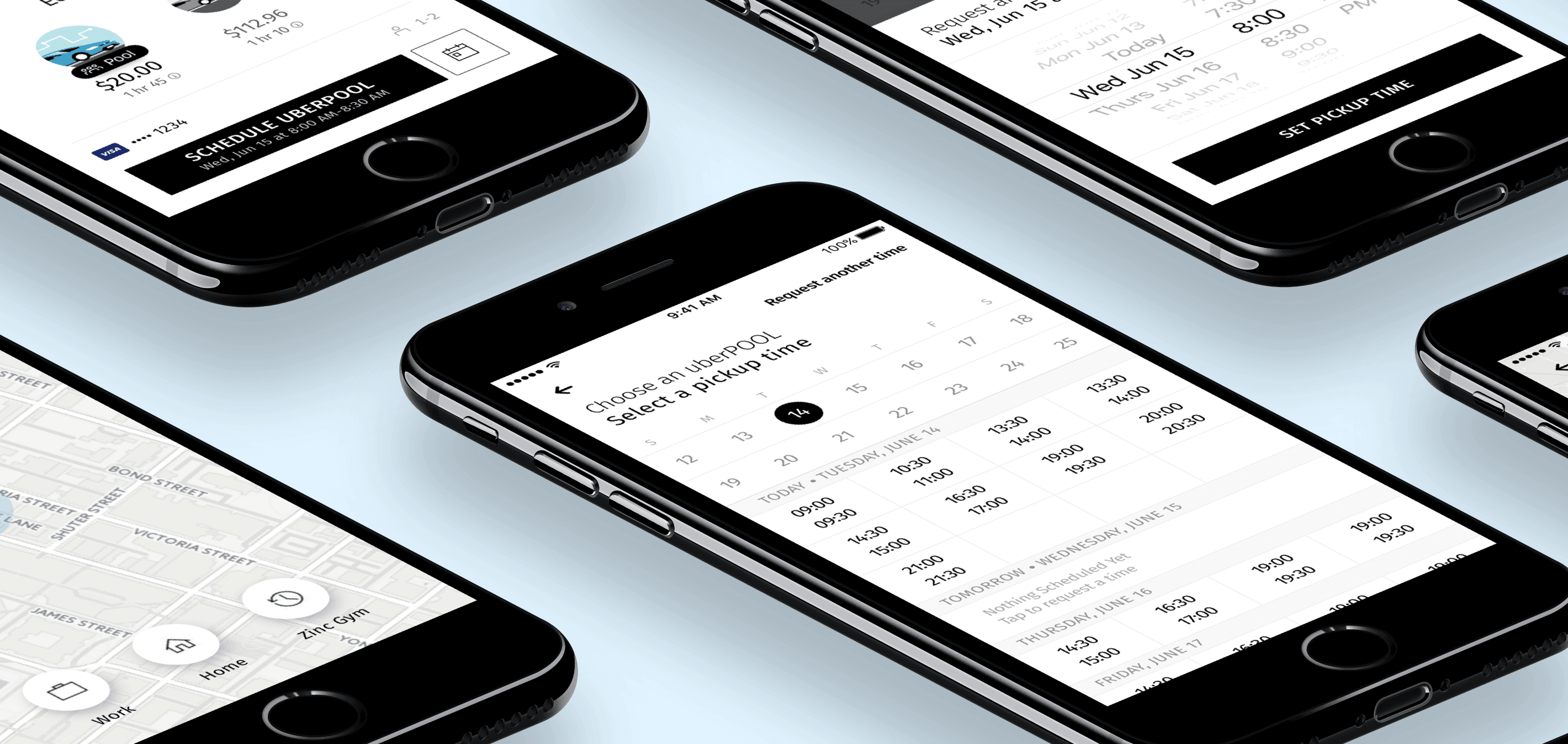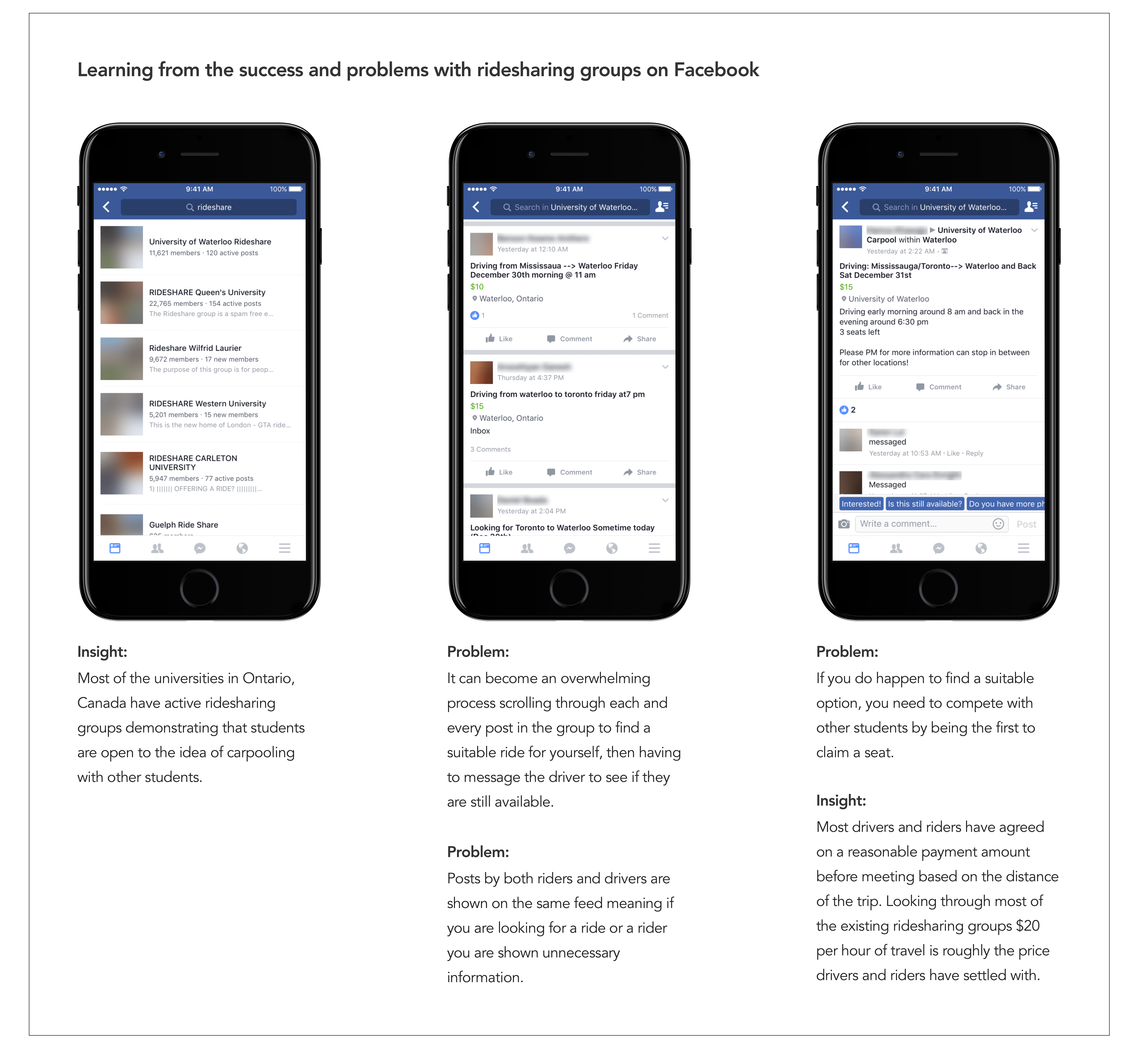Context
Empowering long distance travellers to plan trips together
When I tried using uberPOOL for the first time a couple of months ago in Toronto, I became an instant fan. Sharing a car with someone else, personally, was totally worth the convenience of better price. UberPOOL’s mission of cutting congestion, pollution and parking by turning every car into a shared car aligns with how I believe the world is going to work in the future with the introduction of driverless cars. One way that I believe Uber should expand their outreach of this initiative is by focusing on the needs of unique niche markets and then once the system is perfected, expand to other markets with similar needs. One specific market that I have found reason to believe has potential is focusing on university students. Below I have put together a case study for how Uber could expand its efforts in uberPOOL.
The Problem
Students are getting the short end of the stick
The transportation system that students use to travel between home and university is flawed in many ways. Focusing on the province of Ontario in Canada, a large proportion of students going to university in Ontario are from the city of Toronto. In fact, roughly 50% of the population of Ontario lives in Toronto. With this many people having a home in the city of Toronto, it is a common occurrence to have university students needing a way to go back and forth from their university and home. Personally like the large majority of students at University of Waterloo, as a student living in Toronto, Canada, I very frequently have to experience the burden of organizing a ride for myself to or from school. Currently, no platform has successfully solved this problem that many thousands of students in North America have of going to an from university.
The Goal
Focus on university students as a niche target market
The transportation system that students use to travel between home and university is flawed in many ways. Focusing on the province of Ontario in Canada, a large proportion of students going to university in Ontario are from the city of Toronto. In fact, roughly 50% of the population of Ontario lives in Toronto. With this many people having a home in the city of Toronto, it is a common occurrence to have university students needing a way to go back and forth from their university and home. Personally, like the large majority of students at University of Waterloo, as a student living in Toronto, Canada, I frequently experience the burden of organizing a ride for myself to or from school. Currently, no platform has successfully solved this problem that many thousands of students in North America have of travelling to and from university.
Market Research
Current products just aren't solving the problem
While there are a few possible options for travelling to and from university, the main downside to the reasonably-priced existing options is that students must find their own transportation to one of the 2 pick-up locations within the city of Toronto. This is especially difficult for international students who don’t have family to drive them to a nearby pick-up location and therefore end up requiring to also take an additional mode of transportation, such as public transit to their nearest pick-up location. As outlined below, students are wanting a to be picked-up from a location that is not far from their current location while keeping a reasonable price. This has naturally introduced the uprising of students sharing rides, who connect through Facebook, within the past few years which has brought along a few problems of its own.
Intercity bus services
For many years, taking an intercity bus from the city of Toronto to your respective university has been the standard method of transportation. However, with the inconvenience that comes with it, it is starting to become less and less popular with respect to students using ridesharing groups on Facebook.
Pros
The cost for a bus ride to school is generally priced reasonably for students and on par with the pricing of joining a carpool on Ridesharing Groups on Facebook. A trip from downtown Toronto to University of Waterloo will cost you around $20.
Cons
Student riders need to go through the hassle getting to the bus station, paying for their ticket, waiting for bus to arrive, then arriving at their school to walk to their place of residence.
Taxi services
While taking a taxi is likely to be by far the least popular method of transportation for students travelling to university, it is important to consider so that it is clear what the underlying reasons why the majority of students do not prefer this option.
Pros
Student riders may prefer this option if they need to carry lots of luggage such as when moving in or out of residence or travelling to and from the airport.
Cons
This is the most expensive option for students. A trip from downtown Toronto to University of Waterloo will cost you over $200.
uberPOOL
Since uberPOOL will generally be unavailable for the time and distance that is requested by a student needs to go 100km+ to their school, the student rider may opt to ride an uberX to school.
Pros
Student riders will be able to enjoy the ease of being picked up from their home or wherever location is most convenient.
Cons
Student riders want to ride with other students so they can meet and spend the long drive with another
fellow student from their school.
Both student riders and drivers usually don’t have a strong preference for time of day they would like to be
picked up.
Student riders will need to pay at least 10x the price to ride in an uberX vs. catching a ride from a fellow
student from Facebook Ridesharing Group. A trip from downtown Toronto to University of Waterloo will cost you
over $100.
Students going up to school will generally only need 1 seat. Students would likely rather save money and wait the
extra time to pick up other passengers rather than pay for the extra seats for additional passengers.
Ridesharing Groups on Facebook
The fastest growing option amongst students, nowadays, is students connecting with other students through a ridesharing group on Facebook, where student drivers can connect with students who need to travel to and from the university. All the major universities in the province of Ontario have active ridesharing groups where students can connect with each other. While this is currently the best option for most students, it is nowhere near a perfect system and many improvements can be made in favor of both student drivers and riders.
Pros
The cost for a bus ride to school is generally priced reasonably for students and on par with the pricing of joining a carpool on Ridesharing Groups on Facebook. A trip from downtown Toronto to University of Waterloo will cost you around $20.
Cons
Ridesharing groups is a cumbersome system where drivers have to add their post to the other hundreds of other
daily posts that other student drivers post resulting in their post being seen and not getting riders.
Student drivers need to comment on their post once they have received enough riders or are not driving anymore so
they don’t receive unnecessary messages. On the other hand, student riders sometimes spend time unnecessarily
messaging drivers who are .
Student drivers need to go through the hassle of contacting the student riders.




